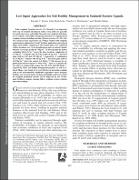| dc.contributor.author | Kaizzi, C. Kayuki | |
| dc.contributor.author | Byalebeka, John | |
| dc.contributor.author | Wortmann, S. Charles | |
| dc.contributor.author | Mamo, Martha | |
| dc.date.accessioned | 2018-07-25T02:27:03Z | |
| dc.date.available | 2018-07-25T02:27:03Z | |
| dc.date.issued | 2007 | |
| dc.identifier.citation | Kaizzi, K.C., Byalebeka, J., Wortmann, C.S. and Mamo, M., 2007. Low input approaches for soil fertility management in semiarid eastern Uganda. Agronomy Journal, 99(3), pp.847-853. | en_US |
| dc.identifier.issn | 847–853 | |
| dc.identifier.uri | http://hdl.handle.net/20.500.12280/521 | |
| dc.description.abstract | Grain sorghum [Sorghum bicolor (L.) Moench] is an important
food crop of semiarid sub-Saharan Africa. Crop yields are generally
low, partly due to low soil fertility. Research was conducted with farmers
to evaluate, soil fertility management practices in sorghum-based
cropping systems including: mucuna [Mucuna pruriens (L.) DC.] fallow;
cowpea [Vigna unguiculata (L.) Walp.] rotation with sorghum;
animal manure application; N and P fertilizer application; and reduced
tillage. Four studies, comprised of 142 on-farm trials, were conducted
at three locations over 3 yr in drought-prone parts of eastern Uganda.
Mucuna on average produced 7 Mg ha21 of aboveground dry matter
containing 160 kg N ha21 across the three locations. Application of
2.5 Mg ha21 of manure and of 30 kg N plus 10 kg P ha21 increased
grain yield by 1.05 and 1.30 Mg ha21, respectively. A combination
of 2.5 Mg ha21 manure with 30 kg N ha21 increased grain yield by
1.50 Mg ha21 above the control (1.1 Mg ha21). The increase in sorghum
grain yield in response to 30 kg N ha21 alone, to a mucuna fallow,
and to a rotation with cowpea was 1.15, 1.55, and 0.82 Mg ha21,
respectively. These soil fertility management practices, as well as reduced
tillage, were found to be cost effective in increasing sorghum
yield in the predominantly smallholder agriculture where inorganic
fertilizer was not used much. On-farm profitability and food security
for sorghum production systems can be improved by use of inorganic
fertilizers, manure, mucuna fallow, sorghum–cowpea rotation,
and reduced tillage.
GRAIN SORGHUM is an important | en_US |
| dc.language.iso | en | en_US |
| dc.publisher | American Society of Agronomy | en_US |
| dc.subject | Soil Fertility Management | en_US |
| dc.subject | Eastern Uganda | en_US |
| dc.subject | Grain Sorghum | en_US |
| dc.title | Low Input Approaches for Soil Fertility Management in Semiarid Eastern Uganda | en_US |
| dc.type | Article | en_US |


